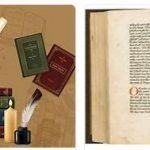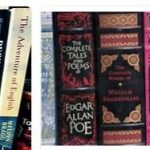
The diverse contrasts of the first half of the century were also reflected in literature, in which the fantastic stood next to the realistic, and concrete world experience next to religious introspection. A change in style began in lyric poetry as early as 1600. On the one hand, it gave rise to the lyrics by J. Donne , G. Herbert , A. Marvell and H. Vaughan, which were later called “Metaphysical Poetry”Their dramatic character, argumentative structure, superimposition of secular and spiritual motifs, dark language overloaded with meaning and paradoxical connection of opposites made them – after centuries of oblivion – an important source of inspiration for the poetry of the 20th century. Opposite to it was the secular, anacreontic, elegant “Cavalier Poetry” of the loyal courtiers, whose most important representatives were R. Herrick , T. Carew and J. Suckling , based on ancient models.
The epic was still considered the highest genre of poetry and remained indebted to the ancient models and E. Spensers ; But the only work of paramount importance, J. Milton’s “Paradise lost” (1667, expanded 1674; German including “Das verlorene Paradies”), does not take up historical or national, but rather religious material, namely the biblical account of creation and the history of salvation.
The extensive prose literature of the 17th century was predominantly scientific, religious and polemical in nature. In addition to learned treatises in the conventional style (e.g. R. Burton’s “Anatomy of melancholy”, 1621), numerous collections of sermons (noteworthy: Lancelot Andrewes (* 1555, † 1626), J. Donne, Jeremy Taylor (* 1613, † 1667), John Robert Tillotson [* 1630, † 1694]) and baroque religious denomination literature (Sir Thomas Browne (* 1605, † 1682), »Religio medici«, 1642) entered Montaigne’s »Essais« (1580, 1588; English translation John Florio (* 1553, † 1625) 1603) and F. Bacons “Essays” (1597, 1612, 1625) a new, promising type of prose in appearance: the essay. Its individual character, skeptical and questioning attitude and stylistic conciseness suited the mentality of the epoch, at the beginning of which F. Bacon’s programmatic work “Advancement of Learning” (1605) had stood. In the period that followed, the essayistic style spread to other literary genres (e.g. the popular character sketches in the style of Theophrastus ) and areas of knowledge (e.g. literary criticism, science and philosophy).
The interest of the epoch in the individual is also evident in the increasing importance of (auto) biographies (e.g. John Aubrey (* 1626, † 1697), “Brief lives” 1669–93; published posthumously in the 19th century), Diaries (S. Pepys , 1660–69; printed 1825) and other forms of self-communication (e.g. J. Bunyan’s puritanically inspired spiritual autobiography “Grace abounding”, 1666). With these genres – and with works that, like J. Bunyan’s Pilgrim’s progress (1678–84) combined allegorical elements with realistic individual world experience – the foundation for the literary form that would dominate the following centuries was laid: the novel.
Restoration
After the end of the interregnum and the return of the Stuarts from exile in France (1660), the social and religious tensions and the critical instability of this era led to an increasing involvement of literature in the public sector. In “Poems on affairs of state” (the title of an anthology first published in 1697), pamphlets, pamphlets and above all in satires, the religious and political core issues of the epoch were discussed daily, controversially and polemically. So grabbed z. B. J. Dryden with his brilliant verse satire “Absalom and Achitophel” (1681) directly into the dispute over the succession to the throne.
Otherwise the courtyard was again the center of cultural life; consequently continental influences became increasingly noticeable (Italian and French opera, French drama, Dutch painting). At the same time, the creative appropriation of classic and ancient models was intensively cultivated through translation, adaptation and allusion.
According to plus-size-tips.com, the drama flourished again after licensing two London theaters (Covent Garden and Drury Lane). Peep box stage and backdrops found their way; Actresses were now admitted. The dramas that were performed on these stages corresponded to the tastes of the courtly aristocratic audience: the so-called heroic drama (e.g. W. Davenant , “The Siege of Rhodes,” 1656–58; J. Dryden, “The conquest of Granada ”, 1670–71) – a verse drama in iambic five-part rhyming pairs (“ heroic couplet”) – brought chivalrous heroes in the conflict between love and honor to the stage. The witty and frivolous moral comedy (» Comedy of Manners “; most important representatives: J. Dryden, G. Etherege , W. Wycherley , A. Behn , after 1690 J. Vanbrugh , W. Congreve and G. Farquhar ), however, celebrated the contemporary urban aristocratic way of life and its central values: elegance, taste, good behavior, wit, erotic charisma. While this form of comedy, after the political upheaval of the ” Glorious Revolution ” (1688–89) towards the end of the century, increasingly oriented itself towards bourgeois-moral norms, at the same time heroic drama became through the tragedies of T. Otway, trained in French classicism, N. Rowesand J. Addisons – and the dramas of Shakespeare , arranged according to the specifications of the classicist set of rules – replaced. The subjects of the heroic drama, however, migrated to the opera (e.g. H. Purcell , ” Dido and Aeneas “, 1690; “King Arthur”, 1691; G. Handel’s operas after 1712).
Classicism, Enlightenment, bourgeois culture, “pre-romanticism”
The ” Glorious Revolution ” of 1688–89, by consolidating the parliamentary monarchy, created the conditions for the political stability that the country needed after the trauma of the civil war and the power struggles of the Restoration period. 1688–89, however, also marked the beginning of a gradual process of social change that had far-reaching consequences for literature.
The first task was of course – in an era that itself as Augustan age (“Augustan age”) realized – to maintain continuity. This was particularly evident in the neoclassical appropriation and imitation of ancient models (especially in the works of A. Pope , J. Gay , J. Swift , S. Johnson ) as well as in the optimistic philosophy of contemporary philosophy (Newton , Locke , Shaftesbury ) to live in a stable world shaped by order and reason.







